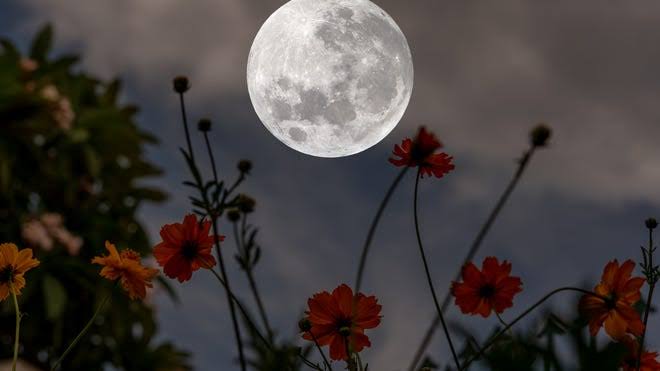May’s Flower Full Moon on Monday, May 12, 2025, is a special astronomical event known as a Micromoon. This article explores why this full moon is unique, how and when to observe it, and what makes it different from other full moons.
What Is the Flower Moon?
The Flower Moon is the traditional name for the full moon that occurs in May. It is called the Flower Moon because it coincides with the time of year when spring flowers are blooming abundantly across North America. This name originates from Native American and colonial American traditions, symbolizing renewal and growth in nature.
Why Is May’s Flower Moon a Micromoon?
The May 2025 Flower Moon is a Micromoon because it occurs when the Moon is at apogee, the farthest point from Earth in its elliptical orbit. The Moon’s orbit around Earth is not a perfect circle but an ellipse, causing the distance between Earth and the Moon to vary throughout the month.
-
Apogee: The Moon is about 405,278 kilometers (approximately 251,828 miles) away from Earth during this full moon, which is farther than its average distance of about 384,400 kilometers (238,855 miles).
-
Because of this increased distance, the Moon appears about 14% smaller and up to 30% dimmer than a typical full moon.
-
This smaller apparent size and brightness is why this full moon is called a Micromoon, the opposite of a Supermoon, which occurs when the Moon is closest to Earth (perigee) and appears larger and brighter.
When and How to Watch the May 2025 Flower Micromoon
-
The Flower Moon reaches its peak illumination at 12:56 p.m. EDT (16:56 UTC) on May 12, 2025.
-
Although the peak is during daylight hours, the Moon will appear full and bright on the nights of May 11, 12, and 13, providing ample opportunity to observe it.
-
The Moon will rise in the southeast around 9:30 p.m. local time and set in the southwest just before dawn.
-
Because the Moon will be in the constellation Libra, it will not rise very high above the horizon in the Northern Hemisphere, making it appear closer to the horizon where it may look larger due to the Moon illusion.
-
For the best viewing experience, find a dark, open location with a clear view of the eastern horizon away from city lights.
Additional Celestial Highlights During the Flower Moon
-
The bright star Antares in the constellation Scorpius will be visible just below and to the left of the Moon.
-
Planets such as Mars, Jupiter, Saturn, Venus, and Neptune will be visible in the evening and early morning skies around the time of the Flower Moon.
-
The Flower Moon’s soft, silvery glow creates a beautiful ambiance for spring nights and connects observers to natural cycles of planting and renewal.
Why Does the Moon Appear Smaller at Apogee?
The Moon’s elliptical orbit means its distance from Earth changes continuously. When the Moon is at apogee, it is about 14% farther away than average, causing its apparent diameter in the sky to shrink by roughly the same percentage. This difference is subtle and often hard to notice without photographic comparison or telescopic observation.
Fun Observation Tip
Try photographing the Flower Micromoon and then compare it to photos of Supermoons later in the year. This will clearly show how the apparent size of the Moon changes between apogee (Micromoon) and perigee (Supermoon) phases1.
Summary of Key Points
-
May’s full moon is called the Flower Moon due to springtime blooms.
-
The 2025 Flower Moon is a Micromoon, occurring at the Moon’s farthest point (apogee).
-
The Moon will be about 405,000 km (251,828 miles) from Earth.
-
It appears approximately 14% smaller and up to 30% dimmer than a typical full moon.
-
Peak illumination is at 12:56 p.m. EDT on May 12, 2025.
-
Visible from the evening of May 11 through early May 13.
-
Best viewed from a dark location with a clear horizon.
-
Additional celestial sights include bright stars and visible planets near the Moon.
Frequently Asked Questions (FAQs)
Q: What is a Micromoon?
A Micromoon is a full moon that occurs when the Moon is at apogee, its farthest point from Earth, making it appear smaller and less bright than usual.
Q: When is the Flower Moon in 2025?
The Flower Moon peaks on May 12, 2025, at 12:56 p.m. EDT but is visible from the evening of May 11 through early May 13.
Q: Can I see the Micromoon without a telescope?
Yes, the Micromoon is clearly visible to the naked eye and does not require any special equipment.
Q: Why is it called the Flower Moon?
It is named after the abundance of flowers blooming in May, reflecting the season of growth and renewal.
Q: How much smaller is the Micromoon compared to a regular full moon?
It appears about 14% smaller and up to 30% dimmer than a typical full moon.
May’s Flower Full Moon Micromoon is a beautiful reminder of the Moon’s dynamic orbit and the changing seasons. Whether you are an astronomy enthusiast or a casual observer, this celestial event offers a chance to connect with nature’s rhythms and enjoy a stunning lunar display.
